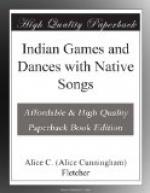Each player has a marker, a small stick or twig, which is called his “horse.” As many can take part in the game as conveniently can seat themselves around the pa-tol house.
The following description of the game is given by Dr. Charles F. Lummis and quoted by Dr. Culin (Ibid., pp. 191, 192): “When the players have seated themselves, the first takes the pa-tol sticks tightly in his right hand, lifts them about as high as his chin and, bringing them down with a smart vertical thrust as if to harpoon the center stone, lets go of them when they are within some six inches of it. The three sticks strike the stone as one, hitting on their ends squarely, and, rebounding several inches, fall back into the circle. The manner in which they fall decides the denomination of the throw, and the different values are shown in the diagram. Although at first flush this might seem to make it a game of chance, nothing could be farther from the truth.... An expert pa-tol player will throw the number he desires with almost unfailing certainty by his arrangement of the sticks in his hand and the manner and force with which he strikes them down. It is a dexterity which any one may acquire by sufficient practice, and only thus. The five throw is deemed very much the hardest of all, and I have certainly found it so. [See diagram.]
“According to the number of his throw the player moves his marker an equal number of stones ahead on the circle, using one of the rivers as a starting point. If the throw is five, for instance, he lays his horse between the fourth and fifth stones and hands the pa-tol sticks to the next man. If his throw be ten, however, as the first man’s throw is very certain to be, it lands his horse in the second river, and he has another throw. The second man may make his starting point the same or another river, and may elect to run his horse around the circle in the same direction that the first is going or in the opposite. If in the same direction, he will do his best to make a throw which will bring his horse into the same notch as that of the first man, in which case the first man is killed and has to take his horse back to the starting point, to try over again when he gets another turn. In case the second man starts in the opposite direction—which he will not do unless an expert player—he has to calculate with a good deal of skill for the meeting, to kill and to avoid being killed by the first player. When he starts in the same direction he is behind and runs no chance of being killed, while he has just as good a chance to kill. But if, even then, a high throw carries him ahead of the first man—for jumping does not count either way, the only killing being when two horses come in the same notch—his rear is in danger, and he will try to run on out of the way of his pursuer as fast as possible. The more players the more complicated the game, for each horse is threatened alike by foes that chase from behind and charge from before, and the most skilful player is liable to be sent back to the starting point several times before the game is finished, which is as soon as one horse has made the complete circuit. Sometimes the players, when very young or unskilled, agree there shall be no killing; but unless there is an explicit arrangement to that effect, killing is understood, and it adds greatly to the interest of the game.”




